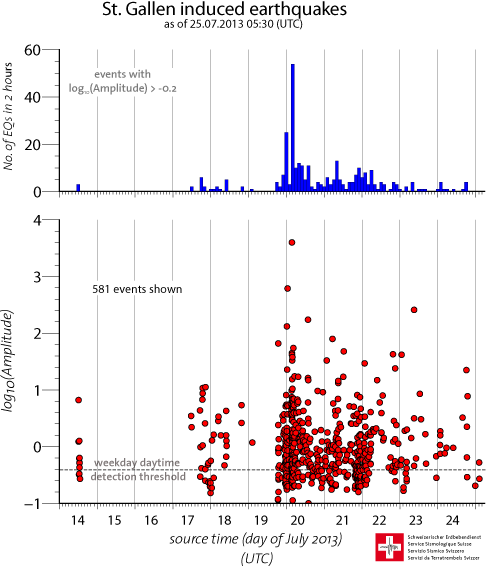Seismic activity has declined further in recent days. Up to and including today the Swiss Seismological Service (SED) has recorded more than 550 earthquakes, whereby, apart from the main earthquake with a magnitude of 3.6 (adjusted to magnitude 3.5 on 20.07.2013), only two were strong enough to be noticed by the population. In the coming days we expect a further reduction in seismic activity, although other, stronger earthquakes remain a possibility.
Following initial analysis of the aftershock sequence, it is clear that the seismic activity is declining in a manner similar to that associated with tectonic (natural) earthquakes. About two-thirds of the anticipated aftershocks have already occurred. According to our estimates the probability of a further, noticeable earthquake is in the 10 to 30 percent range. The probability that another earthquake occurs with a magnitude similar to or greater than the main tremor on July 20, 2013, is two to five percent.
Read more...The SED presented these observations together with further provisional results from initial investigations to the authorities in St. Gallen on Friday, July 26, 2013. The SED’s analysis concentrates on understanding in detail the processes underlying the observed seismic activity with the intention of being able to forecast the further course of this and other earthquake sequences. Besides this, comparisons were made with seismic data recorded in the course of other geothermal energy projects.
From the Earthquake Catalog of Switzerland (ECOS-09) it is known that several tectonic earthquakes have occurred in the St. Gallen region in the past. Most earthquakes in the St. Gallen area were relatively weak, with only three known to have caused damage. There was one near Niedersommeri on August 11, 1771, with a magnitude of 5.1, and two with a magnitude of 4.7, one near Arbon on December 20, 1720, and the other near Abtwil on October 29, 1835. Because the data for these earthquakes stems from historical documents, the information about locations and earthquake parameters may not be entirely reliable.
